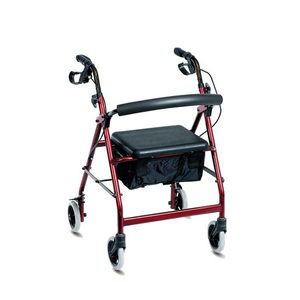Walking aids have become an essential tool for individuals with mobility challenges, offering them the freedom to move independently. As the demand for these aids grows, so does the need for customization and versatility. One of the most sought-after features in modern walking aids is the ability to attach accessories, enhancing both functionality and comfort. This research paper explores the types of walking aids that allow attachments, the benefits of such features, and the implications for manufacturers, distributors, and retailers in the mobility aid industry.
The integration of attachments into walking aids not only improves the user experience but also opens up new opportunities for businesses in the mobility aid sector. For example, companies like Topmedi offer a wide range of walking aids with customizable features, making them a key player in this evolving market. By understanding which walking aids allow attachments and how these features can be leveraged, businesses can better serve their customers and stay competitive.
Types of Walking Aids That Allow Attachments
Walking aids come in various forms, each designed to meet specific mobility needs. The most common types include canes, crutches, walkers, and rollators. Among these, rollators and walkers are the most versatile when it comes to allowing attachments. These devices often feature frames that can accommodate a range of accessories, from baskets and trays to cup holders and oxygen tank holders.
Rollators
Rollators are a popular choice for individuals who require more stability than a cane or crutch can provide. These devices typically come with four wheels and a seat, allowing users to rest when needed. Rollators are particularly well-suited for attachments due to their sturdy frame and design. Common attachments include:
These attachments can significantly enhance the functionality of the rollator, making it more than just a mobility aid. For instance, a user can carry groceries or personal belongings without needing an additional bag or cart. Companies like Topmedi offer a variety of rollators with customizable options, allowing users to choose the attachments that best suit their needs.
Walkers
Walkers, particularly those with two or four wheels, are another type of walking aid that allows for attachments. While they are generally more basic than rollators, walkers can still accommodate several useful accessories. These include:
Glide skis for smoother movement
Walker trays for carrying items
Walker bags for additional storage
Cane holders
The ability to add these attachments makes walkers more versatile and user-friendly. For example, a walker tray can turn the device into a portable table, allowing users to eat or drink without needing to sit at a traditional table. This level of customization is particularly appealing to distributors and retailers looking to offer a wide range of options to their customers.
Benefits of Attachments for Walking Aids
The ability to add attachments to walking aids offers several benefits, both for users and businesses. For users, these attachments can enhance the functionality of their walking aid, making it more convenient and comfortable to use. For businesses, offering walking aids with customizable features can increase customer satisfaction and drive sales.
Enhanced Functionality
Attachments such as baskets, trays, and oxygen tank holders allow users to carry personal items, food, and medical equipment without needing additional assistance. This enhances the independence of the user, making the walking aid more than just a mobility device. For example, a rollator with a basket can serve as both a walking aid and a shopping cart, allowing users to run errands without needing extra help.
Increased Comfort
Attachments like padded seats, backrests, and cup holders can make walking aids more comfortable to use. This is particularly important for individuals who rely on their walking aid for extended periods. A rollator with a padded seat and backrest, for example, allows users to take breaks and rest comfortably, reducing fatigue and improving their overall experience.
Customization Options
For businesses, offering walking aids with customizable attachments can be a significant selling point. Customers are more likely to choose a product that meets their specific needs, and the ability to add or remove attachments allows them to tailor the device to their preferences. This level of customization can also lead to repeat business, as customers may return to purchase additional attachments or accessories.
Implications for Manufacturers, Distributors, and Retailers
The growing demand for walking aids with attachments presents several opportunities for manufacturers, distributors, and retailers. By offering products that allow for customization, businesses can differentiate themselves from competitors and attract a broader customer base. Additionally, the ability to offer a wide range of attachments can increase sales and customer loyalty.
Manufacturers
For manufacturers, the key to success lies in designing walking aids that are both functional and customizable. This requires a focus on durability and versatility, ensuring that the walking aid can accommodate a variety of attachments without compromising its stability or safety. Walking aids Manufacturers like Topmedi have already recognized this trend and offer walking aids with a range of attachment options, allowing users to customize their device to suit their needs.
Distributors
Distributors play a crucial role in ensuring that walking aids with attachments reach the right markets. By partnering with manufacturers that offer customizable products, distributors can provide their customers with a wider range of options. This not only increases customer satisfaction but also opens up new revenue streams, as customers may purchase additional attachments over time.
Retailers
For retailers, offering walking aids with attachments can be a significant competitive advantage. Customers are more likely to choose a product that meets their specific needs, and the ability to add or remove attachments allows them to tailor the device to their preferences. Retailers can also benefit from offering a range of attachments as add-on purchases, increasing their overall sales and customer loyalty.
In conclusion, walking aids that allow attachments offer significant benefits for both users and businesses. For users, these attachments enhance the functionality and comfort of their walking aid, making it more than just a mobility device. For businesses, offering walking aids with customizable features can increase customer satisfaction and drive sales. Companies like Topmedi are leading the way in this market, offering a wide range of walking aids with customizable options.
As the demand for walking aids continues to grow, businesses that offer products with attachments will be well-positioned to meet the needs of their customers and stay competitive in the mobility aid industry. Whether you are a manufacturer, distributor, or retailer, understanding the benefits of walking aids with attachments is essential for success in this evolving market.





















